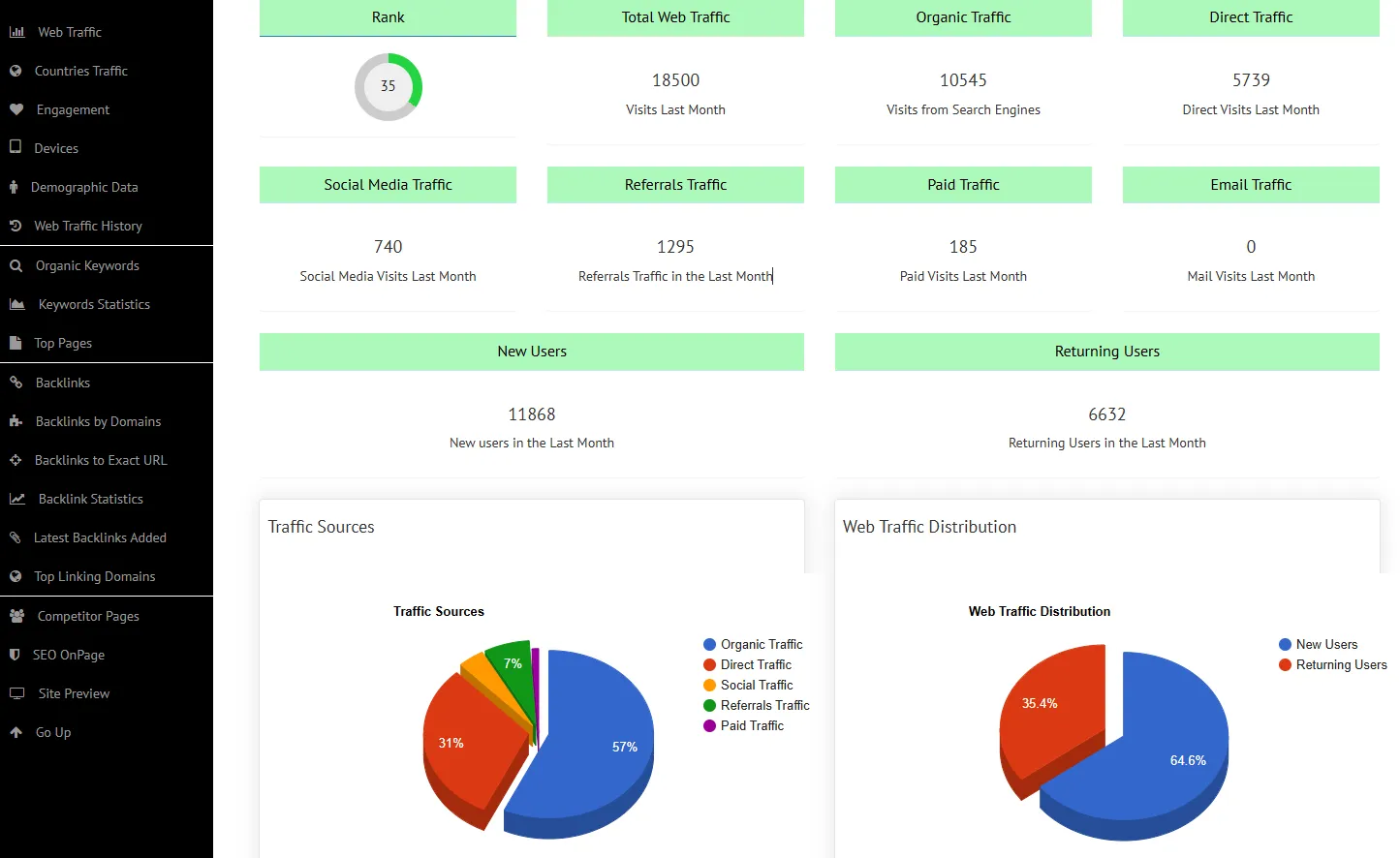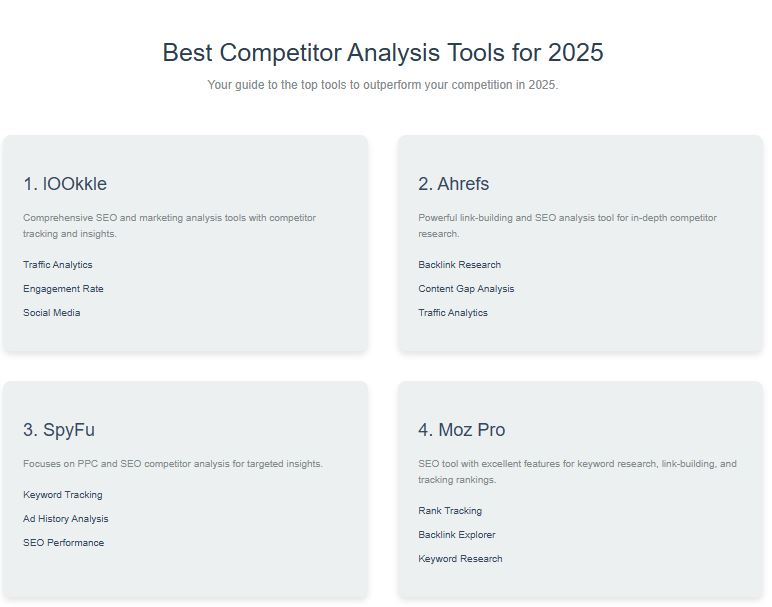
What is SEO Site Explorer?
lOOkkle's SEO Site Explorer is a powerful tool that allows you to analyze the SEO performance of any website.
You can view visits or traffic, backlinks, keywords ranking in major search engines, top pages, technical issues within the website, and even spy on your competitors.
It's like taking a digital x-ray of any site to discover what's working and where there are opportunities for improvement, whether you want to improve your own site or analyze competitors' websites to see where they're outperforming you.
Why Use SEO Site Explorer?
Nowadays, having a website isn't enough. You need to know exactly how it performs in search engines, what's driving it... and what's holding it back.
SEO Site Explorer is your strategic ally to see beyond appearances and make decisions based on real data.
Here's how it can help you:
See where your site's traffic is coming from
Not all visitors come from Google. Some come through social media, others through external links, or even type in your website directly.
With SEO Site Explorer you can:
- Visualize traffic sources (organic, direct, social, referral).
- Compare traffic by device (mobile vs. desktop).
- See which countries generate the most visits and how that varies month to month.
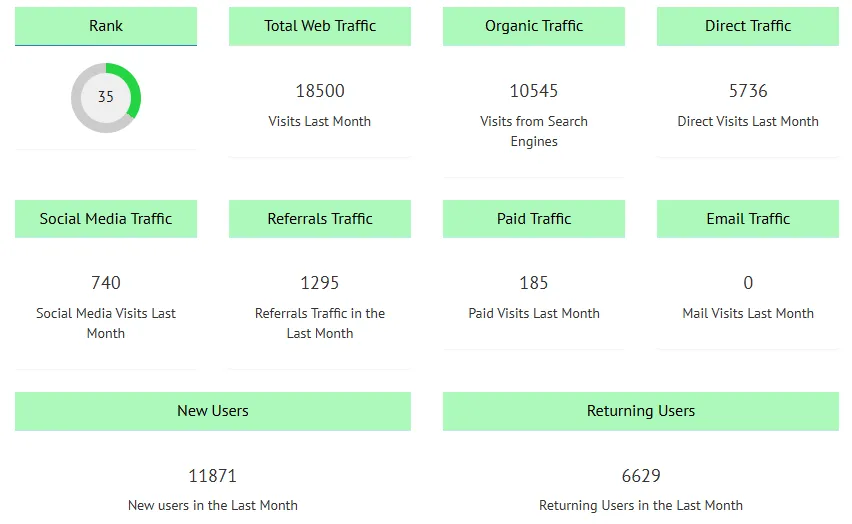
This allows you to optimize your marketing efforts:
- Is it worth investing more in Instagram?
- Is your audience more active on mobile?
- Are you receiving visits from unexpected countries?
Discover which keywords are ranking (and which ones are missing)
Keywords are the foundation of SEO. If you don't know what terms people are finding you for, you're flying blind.
With SEO Site Explorer you can:
- See all the keywords your site appears for in Google.
- Analyze their search volume, difficulty, and current position.
- Detect opportunities: related keywords where you don't yet appear.
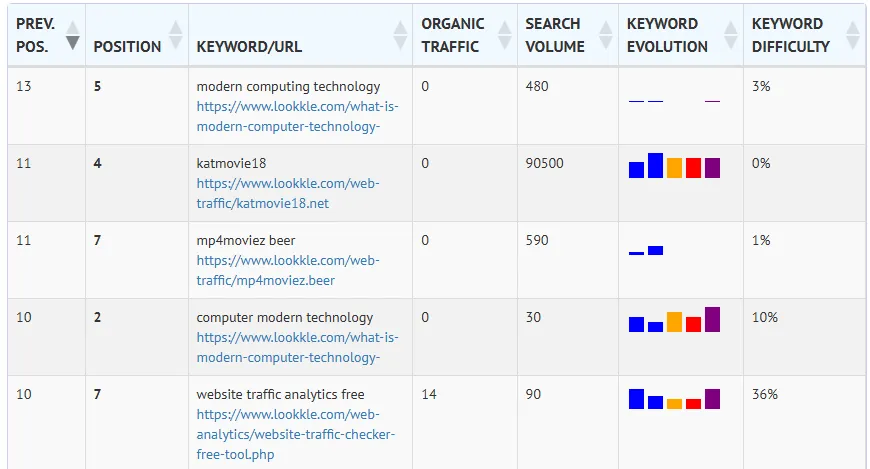
♦ This information helps you create more strategic content, adjust your titles and metadata, and better position yourself against your competitors.
Analyze your backlink profile and find opportunities
Backlinks remain one of the most important factors for ranking on Google. But not all links are equal.
SEO Site Explorer allows you to:
- See how many inbound links you have and which sites they come from.
- Review the anchor text used to link to you.
- Detect new, lost, or potentially toxic links.

⇒ You can also discover what backlinks your competitors have and replicate them. This makes your link profile stronger, more natural, and more effective.
Observe your competitors and understand why they're growing
Does your competition appear before you in Google? How do they get so much traffic?
SEO Site Explorer also allows you to analyze any other public domains, such as:
- The pages that generate the most traffic for them.
- The most profitable keywords they rank for.
- Their most valuable backlinks.
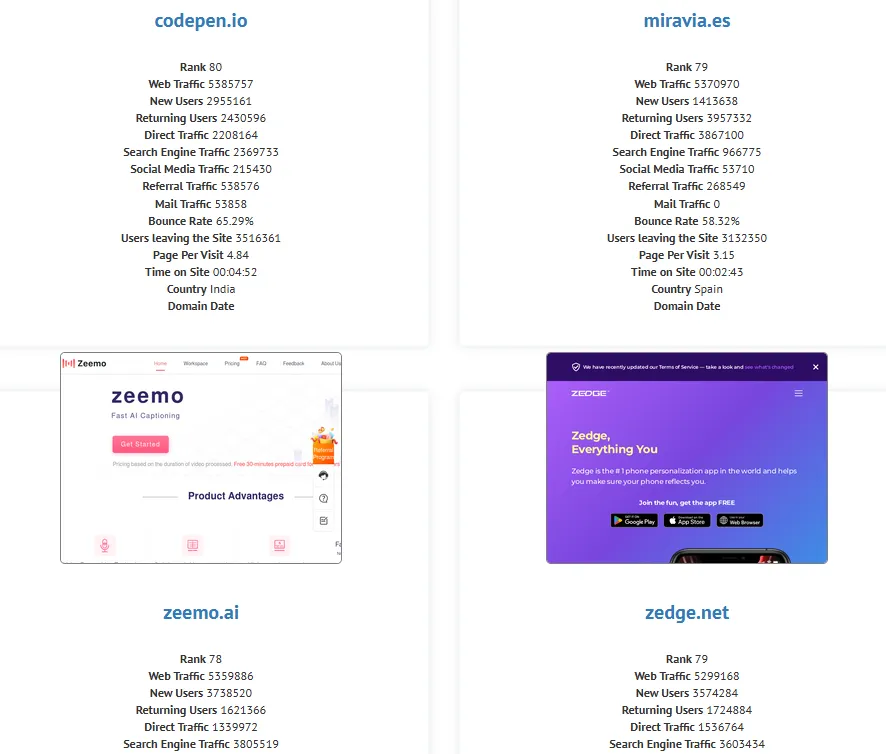
⇒ This way, you can learn from their strategies, find gaps they're not covering, and take advantage of them to rank yourself.
Measure your SEO improvements over time
Doing SEO without historical data is like running without knowing if you're making progress.
SEO Site Explorer allows you to:
- Compare SEO performance month over month or year over year.
- Detect traffic drops and act quickly.
- See if your efforts (new content, link building, optimization) are actually yielding results.
⇒ It's ideal for freelancers, agencies, and marketing teams that need to demonstrate progress and justify actions with real metrics.
Getting Started: Step-by-Step Guide
1. Access SEO Site Explorer
-
In the Main Panel, click the SEO Site Explorer link.
-
Enter the full URL you want to analyze (e.g., www.yoursite.com) and click SEARCH.
Tip: You can analyze your own site or any public domain.
2. Review the Overview Report
After the analysis, you'll see the Website Summary, which displays the following key data:
-
Estimated monthly traffic.
-
Traffic Trends over time.
-
Engagement: time on site, pageviews per visit, etc.
-
Traffic by device (mobile vs. desktop).
-
Traffic by country.
-
Total backlinks.
-
Main pages of the site.
-
Keywords for which it ranks in search engines.
-
Competitor websites.
-
Technical analysis of the site.
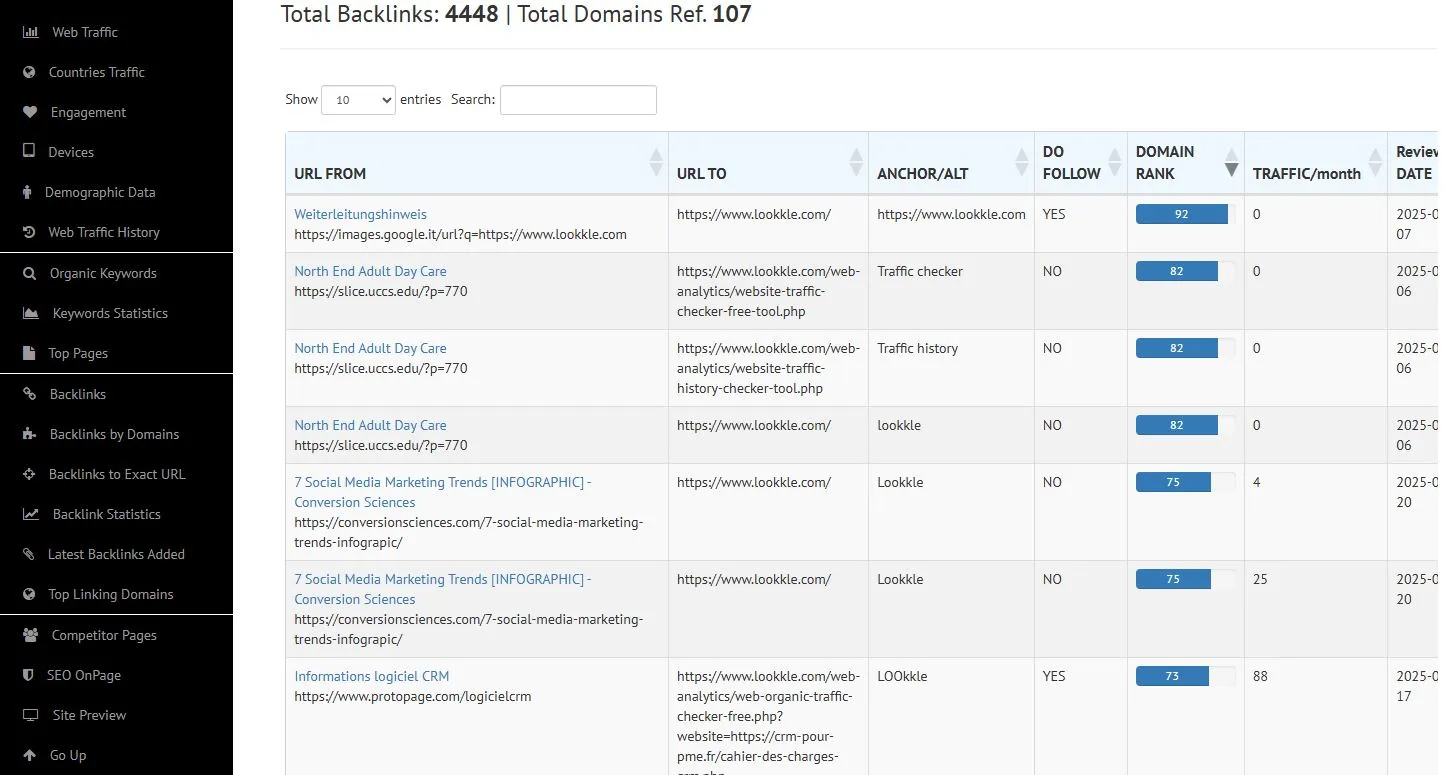
Tip: Observe trends. A sudden drop or spike can indicate a problem or an opportunity.
Detailed Analysis: Key Features
Web Traffic
Track total visits to a website and see how users interact over time.
See how much overall traffic a website receives, whether it's growing, declining, or staying stable.
Use case: You manage a news site and want to see if your recent redesign impacted visits. Web Traffic shows whether your visitor numbers have increased or dropped post-redesign.
Traffic Sources Breakdown
Organic Traffic
Traffic from unpaid search engine results (e.g., Google, Bing).
Use case: After publishing an SEO-optimized blog post, organic traffic to your blog section increases by 40%. This validates your keyword strategy is working.
Direct Traffic
Visitors who type your URL directly or have it bookmarked.
Use case: After attending an industry event and sharing your domain on flyers, direct traffic increases. You measure how effective offline marketing was.
Social Media Traffic
Traffic from platforms like Facebook, Twitter, LinkedIn, or Instagram.
Use case: You launch a product teaser on Instagram. Traffic spikes from Instagram Stories—helping you justify more investment in social ads.
Referrals Traffic
Traffic from other websites linking to yours (excluding search engines).
Use case: A guest post you wrote on a partner site links back to your service page. Referral traffic from that post becomes one of your top converters.
Paid Traffic
Traffic from paid campaigns—Google Ads, Meta Ads, or other PPC platforms.
Use case: You spend $200 on Google Ads and use SEO Site Explorer to track how much of that traffic converts. Low performance? You adjust the copy or landing page.
Email Traffic
Visitors who arrive via email newsletters or campaigns.
Use case: You run a product launch campaign via Mailchimp. Email traffic spikes for three days—you compare open rate with landing page visits to refine your strategy.
New vs. Returning Users
New Users
First-time visitors to your site.
Use case: A YouTube collaboration drives thousands of new users to your homepage. You monitor whether those users continue exploring or bounce right away.
Returning Users
Visitors who come back after their first visit.
Use case: You offer a downloadable SEO checklist. A user visits, downloads it, then returns two days later to explore more tools. You track this pattern to enhance retention features.
Countries Traffic
See which countries your visitors come from.
Break down traffic by geographic region to identify international opportunities or focus areas.
Use case: You notice a sudden spike in visitors from Brazil. You might consider translating key content into Portuguese or running a campaign targeted at that region.
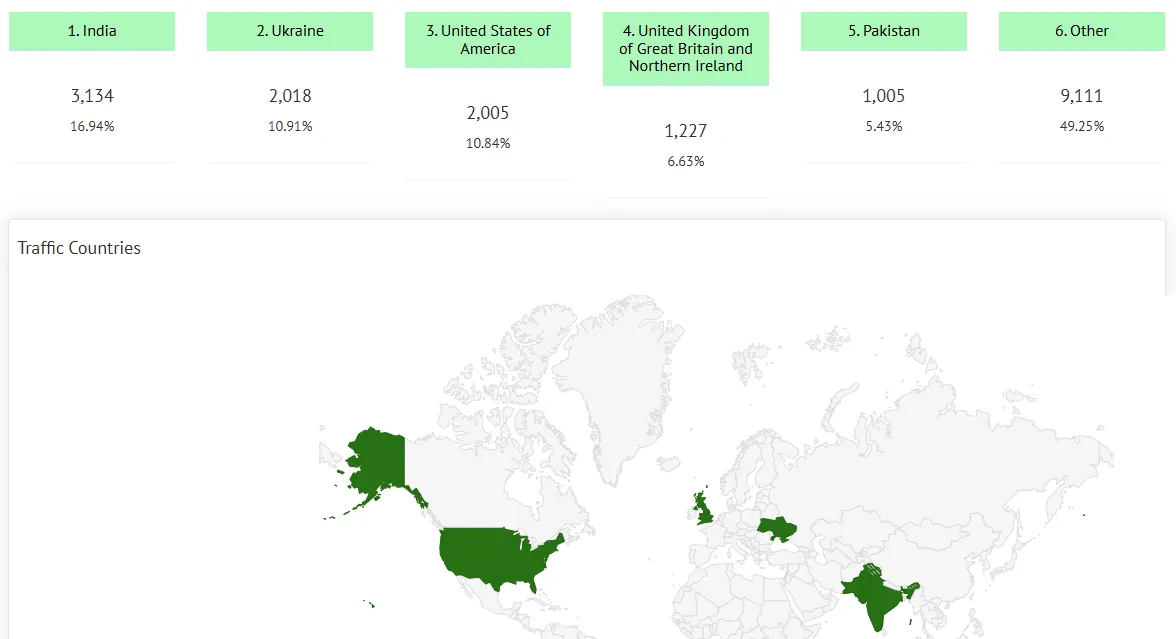
Engagement
Measure how users interact with your content.
Track bounce rate, average session duration, and pages per visit to evaluate content quality.
Use case: A product page has high traffic but a 90% bounce rate. This means users aren’t finding what they need—so you update the layout and simplify the CTA to improve engagement.
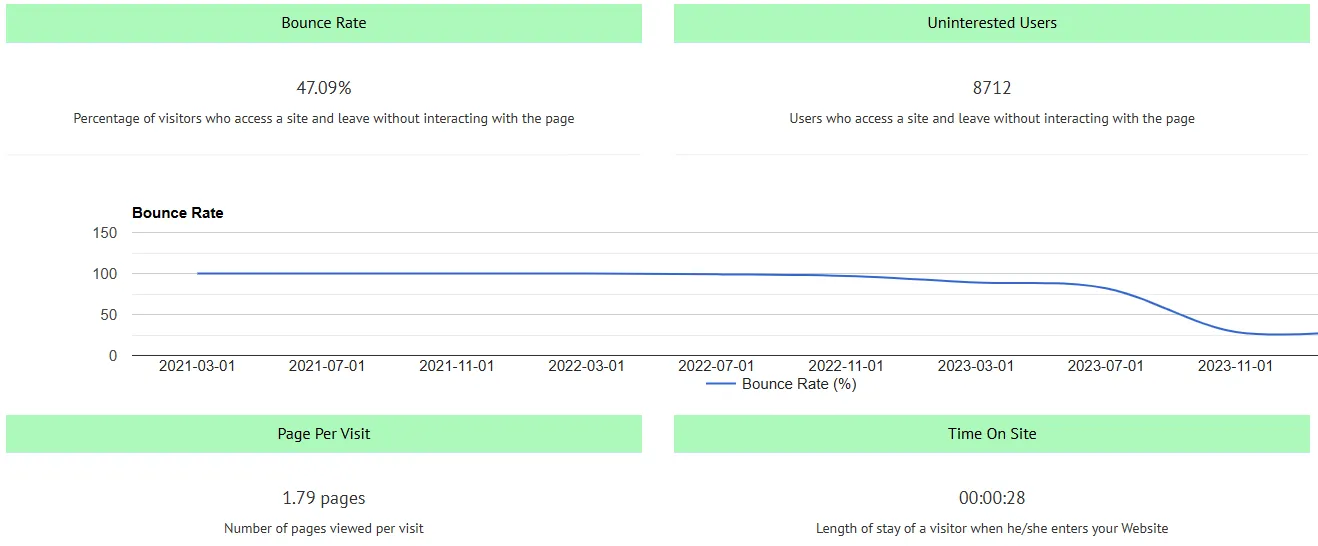
Devices
See what devices users are browsing from—desktop, mobile, or tablet.
This helps you optimize your website’s design for the dominant device type.
Use case: Your analytics show 75% of users are on mobile, but your site loads slowly on phones. You decide to optimize images and apply mobile-first design.
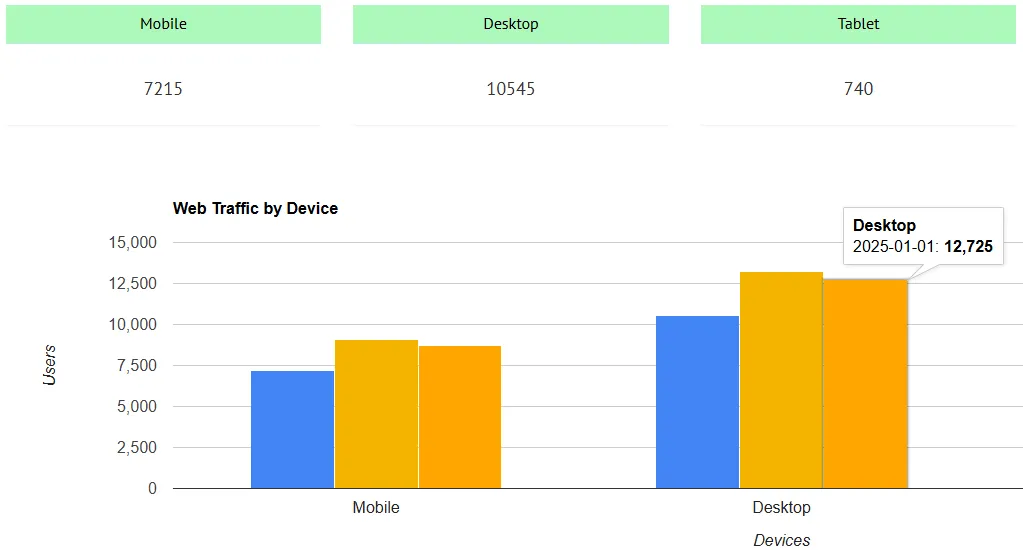
Demographic Data
Understand your audience’s age, gender, and interests.
Gain insights into who your visitors are to improve targeting and personalization.
Use case: Your fashion blog shows most users are women aged 25–34. You begin producing more style guides tailored to this demographic, increasing engagement.
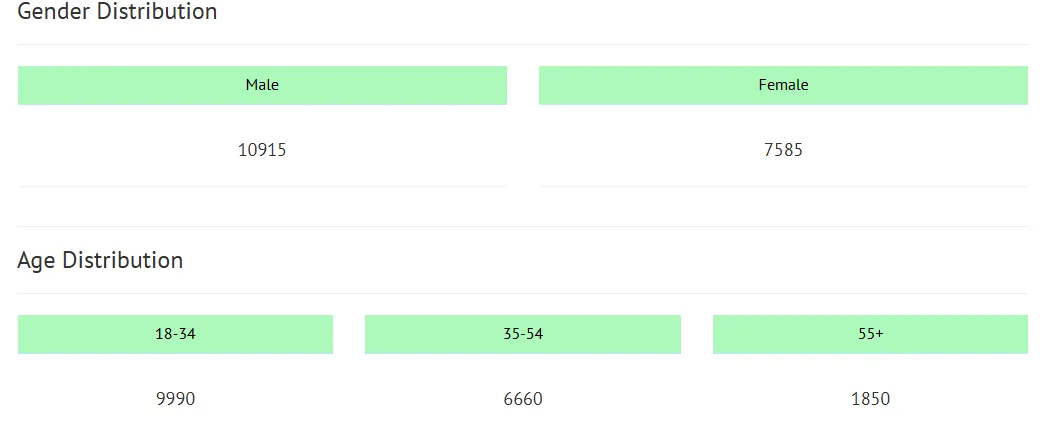
Web Traffic History
See how traffic has evolved over time.
Track growth trends, seasonality, or the impact of marketing campaigns.
Use case: After launching a YouTube channel in January, you track monthly traffic. By April, organic visits have doubled—proving your video content is working.
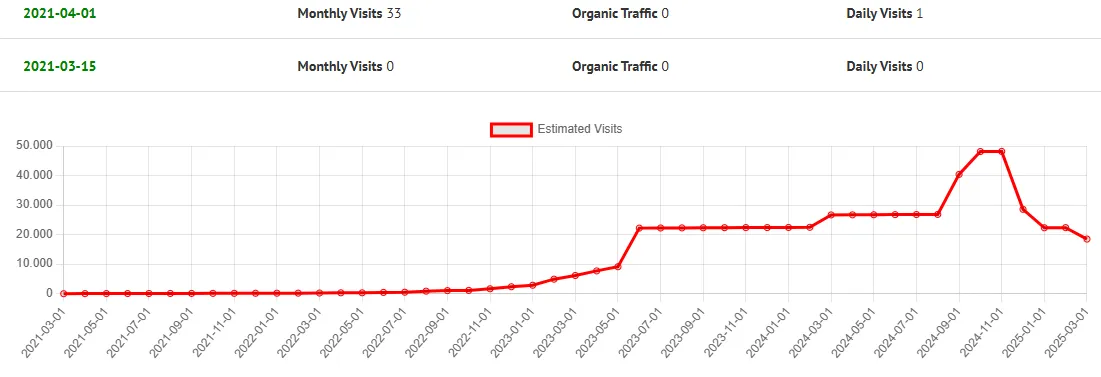
Organic Keywords
List all the keywords your site ranks for in search engines.
Track ranking position, search volume, keyword difficulty, and evolution over time.
Use case: Your site ranks #8 for “sustainable home office ideas,” which gets 10,000 monthly searches. You optimize the article to move up in rankings and gain more traffic.

Keywords Statistics
Analyze keyword performance in detail.
Review trends, clicks, impressions, and country-specific stats.
Use case: You manage an eCommerce site. A keyword with 3,000 monthly impressions gets only 50 clicks. That’s a red flag—so you rewrite the meta title to boost CTR.
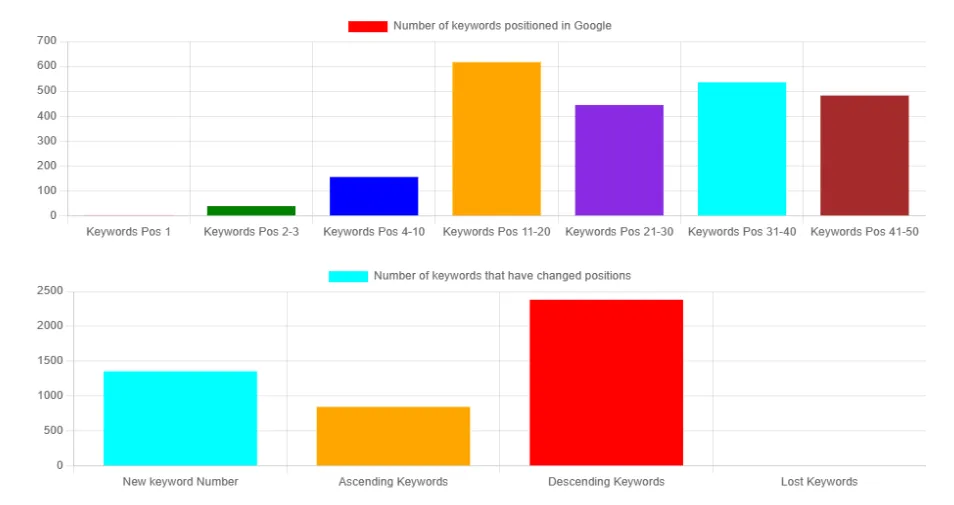
Top Pages
Identify the most visited pages on your website.
Learn what content performs best and why.
Use case: You run a blog. One guide on “Remote Work Tools” gets 80% of your organic traffic. You decide to update it regularly and build related articles to boost session duration.
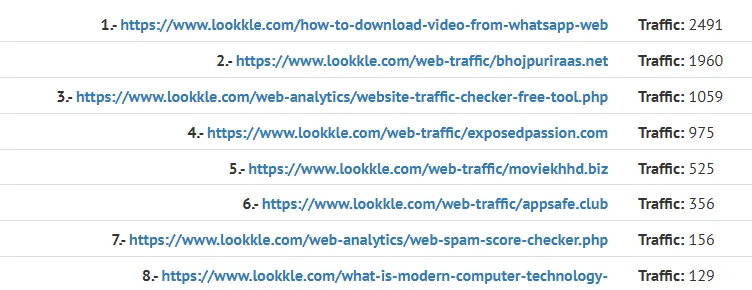
Backlinks
See all websites linking to your domain.
Includes anchor text, referring page, link type (dofollow/nofollow), and authority.
Use case: A well-known blog links to your article. You monitor traffic spikes and use this success to reach out to other publishers for similar backlinks.
Backlinks by Domains
View all referring domains linking to your site.
Group backlinks by source to see who supports your domain authority.
Use case: You find that 20% of your backlinks come from low-quality directories. You plan to disavow some of them to clean up your backlink profile.

Backlinks to Exact URL
Analyze backlinks pointing to a specific page.
Track how individual pages are gaining (or losing) authority.
Use case: Your homepage has strong backlinks, but your product page doesn’t. You start building links directly to the product page to increase its visibility in search.
Backlink Statistics
Measure overall link-building performance.
Track total links, referring domains, link types, and growth rate.
Use case: You want to evaluate an SEO agency’s performance. You compare backlink growth before and after hiring them to validate their results.
Latest Backlinks Added
See the most recent links pointing to your site.
Track new opportunities or monitor recent PR and outreach efforts.
Use case: You launched a press release two weeks ago. This report helps you confirm which sites picked it up—and which ones you might follow up with.
Top Linking Domains
Identify the most valuable domains linking to your site.
Sort by domain authority, traffic, or number of links.
Use case: A high-authority educational site links to you. You use that success to pitch similar .edu and .gov sites for future collaborations.
Competitor Pages
Analyze specific pages of your competitors.
See which URLs are getting the most traffic and why.
Use case: Your competitor’s pricing page ranks higher than yours. You reverse-engineer their structure and add missing elements (FAQs, trust signals, keywords) to your version.
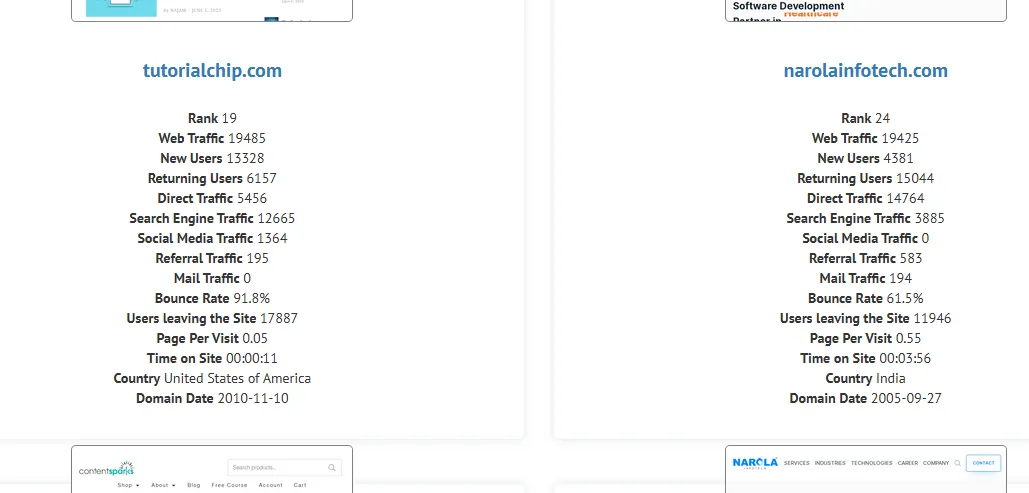
SEO OnPage
Audit and improve the technical SEO of your pages.
Check title tags, meta descriptions, headers, image alt text, URL structure, internal linking, and speed.
Use case: A blog post ranks #11 in Google. On-page analysis shows the H1 is missing and the image doesn’t have alt text. You fix both and move into the top 10.
Another use: You find that your product page has duplicated meta titles and slow load time on mobile—so you optimize it and improve your ranking + user experience.
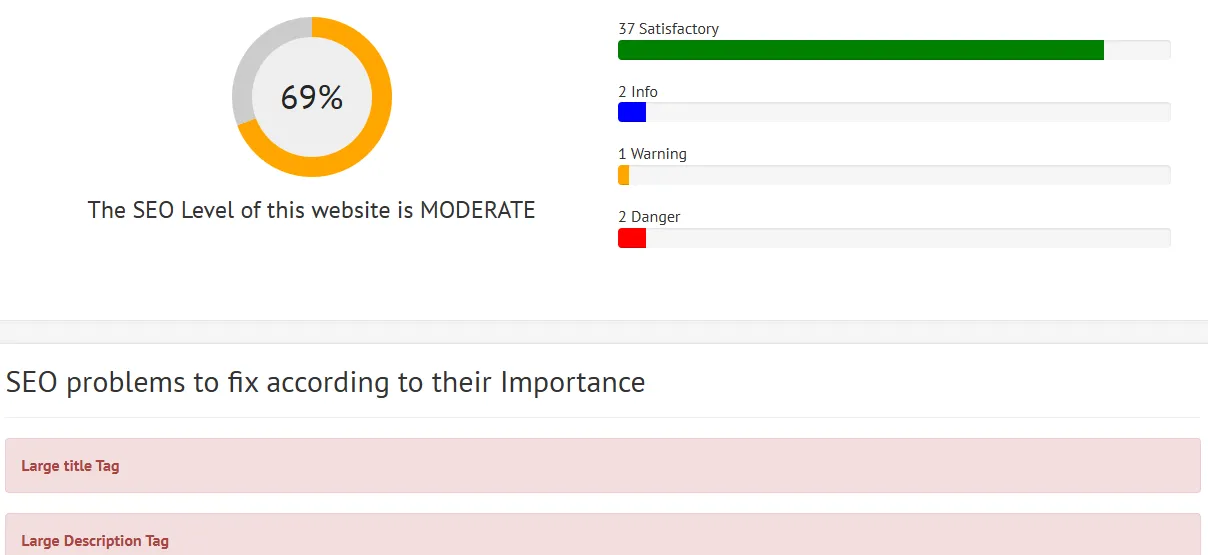
Tips for Better Use
- Save a benchmark: Download your first report to compare progress.
- Conduct periodic reviews: Analyze your site monthly and your competitors' every quarter.
- Export the data: Useful for presentations or teamwork.
- Prioritize actions: Focus on pages that already have some traffic and could use some improvement.
Common Mistakes to Avoid
- Only looking at traffic: keywords and backlinks are key.
- Ignoring mobile: most users browse from mobile.
- Not comparing over time: you need a baseline to see progress.
- Forgetting about competitors: if you don't see them, they see you.
Conclusion: SEO Site Explorer
In today’s digital landscape, visibility is everything and data is the key to achieving it. That’s exactly where SEO Site Explorer by Lookkle shines. It goes far beyond basic SEO tools by offering a complete, user-friendly suite for marketers, founders, content creators, and SEO professionals alike.
With this tool, you're not just guessing what works you’re seeing the full picture:
-
Track where your web traffic comes from, whether it's organic, social, paid, referral, or email.
-
Pinpoint the countries and devices that drive your audience behavior.
-
Compare historical trends to understand growth, stagnation, or seasonal shifts.
-
Analyze organic keywords, discover missed opportunities, and improve search rankings.
-
Uncover backlinks, find toxic links, replicate competitor strategies, and grow your domain authority.
-
Spy on competitor pages and understand what makes them rank.
-
Fix on-page SEO issues that silently hurt your performance—like duplicate titles, missing headings, or slow loading speeds.
-
See how users engage with your content—and whether they come back.
Each feature is backed by clear, practical use cases, making this tool not just powerful—but actionable. Whether you're optimizing a blog post, planning an ad campaign, pitching investors, or analyzing your competition, Lookkle’s SEO Site Explorer provides the clarity and insight to make smart, data-driven decisions.
If you want to truly understand what drives your site’s success and how to scale it, SEO Site Explorer isn’t optional. It’s essential.
Tips on SEO and Online Business
Previous Articles
